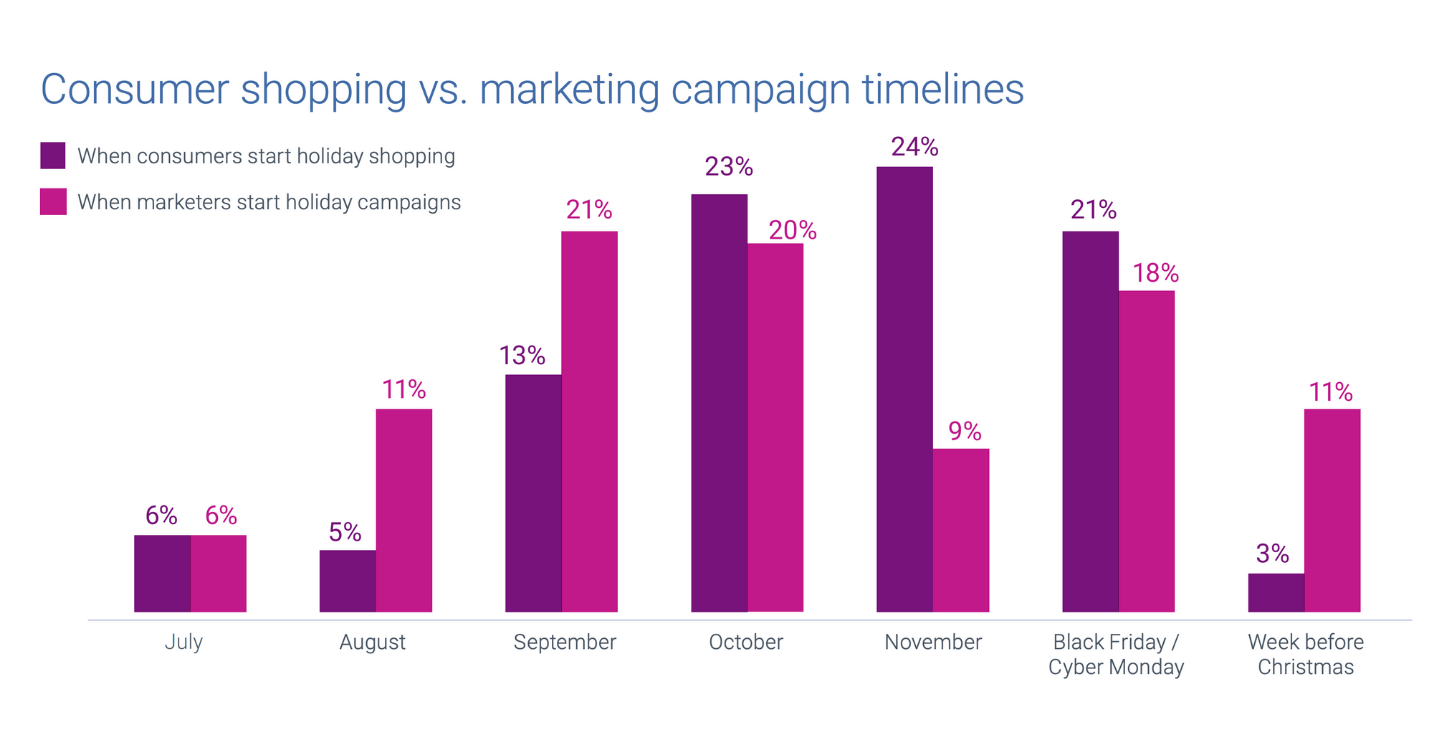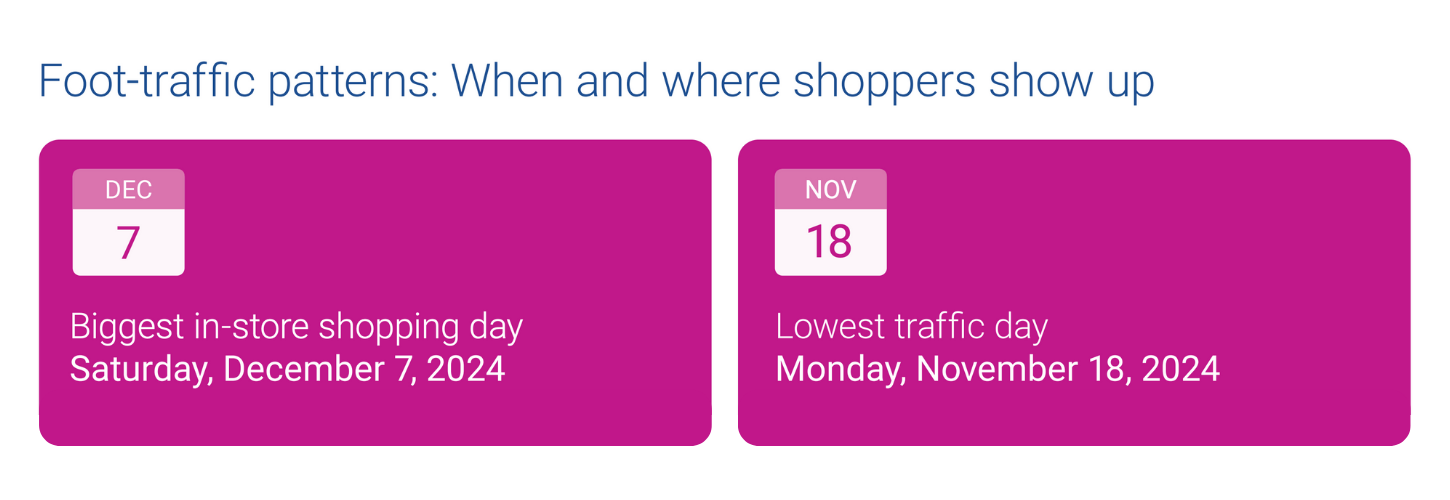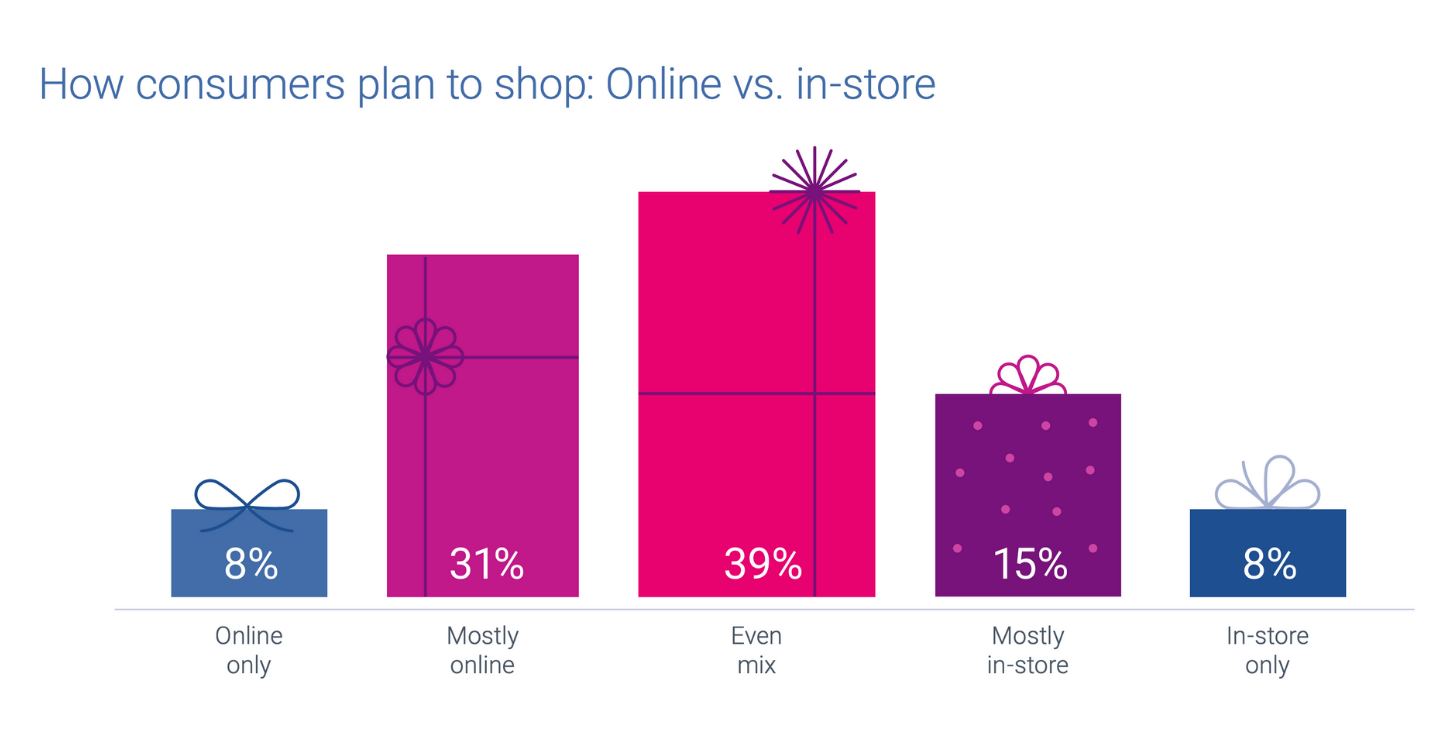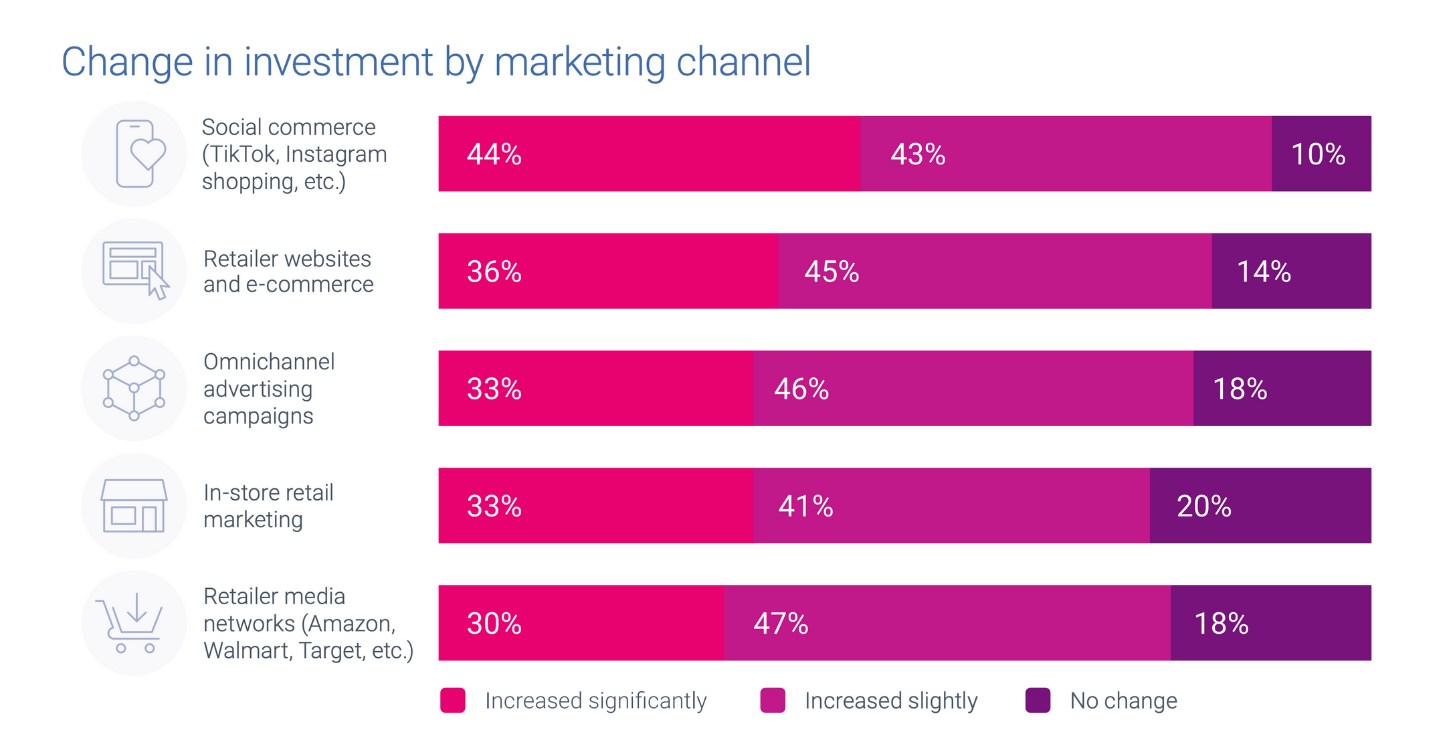At A Glance
Holiday shopping in 2025 doesn’t follow one clear pattern, with shoppers blending early planning and last-minute purchases, digital discovery and in-store validation, and cautious spending. Marketers who embrace this complexity, by staying relevant, consistent, and connected across channels, will be best positioned to win this season.Holiday shopping in 2025 feels a lot like a complicated relationship. Shoppers want deals, but they also want trust. They start shopping early, but they’re still browsing well into December. They love the convenience of online shopping, but they still show up in-store before making the final call.
Our 2025 Holiday spending trends and insights report, created this year in collaboration with GroundTruth, explores these contradictions. Our findings show that this year’s holiday season isn’t about one big shift; it’s about managing the push and pull between what consumers say, what they do, and how marketers respond.
Here are three complicated truths you need to know.
Experian’s 2025 Holiday spending trends and insights report
Optimize your 2025 holiday shopping campaigns with our latest report with GroundTruth.
Download now1. The new rules of holiday timing
Almost half (45%) of consumers plan to start shopping before November, but 62% admit they’ll still be buying in December. And post-holiday shopping (think gift card redemptions and deal-hunting) remains a real factor.


Why it’s complicated
The holiday calendar isn’t what it used to be. There’s no single “big moment” anymore. Instead, shoppers are spreading purchases across months, peaking around the “Turkey 12” (the 12 days surrounding Thanksgiving) and again in the final December rush.
What to do about it
- Stretch your campaigns across the full season, not just Cyber Week.
- Refresh offers to stay relevant as shopper motivations change from deal-seeking to last-minute urgency.
- Watch for post-holiday momentum and extend your promotions into January.
How belVita nailed the timing
In celebration of National Coffee Day, belVita partnered with GroundTruth on a one-month campaign to boost product awareness and drive foot traffic to Target stores. By utilizing digital out-of-home (DOOH) and mobile ads powered by location, behavioral, and purchase-based targeting, the campaign achieved a 3.44% visitation rate, nearly $476k in products added to carts, and a low cost-per-visit of just $0.22.
2. Online leads, but in-store still seals the deal
Nearly 40% of shoppers say they’ll split their purchases between online and in-store and 80% of consumers still prefer the in-store experience. Only a small fraction plan to shop exclusively in one channel. That means while digital often starts the journey, the final decision often happens in a physical store.

Why it’s complicated
Shoppers love the convenience of browsing online, but they still want the reassurance of seeing, touching, or testing products before buying. In-store isn’t just about the transaction, it’s the validation step.
What to do about it
- Build omnichannel strategies that connect digital discovery with in-store follow-through.
- Use location and identity data to tie digital impressions to real-world actions, like foot traffic and purchases.
- Focus on consistency: shoppers expect the same value, tone, and trust whether they’re on a website, in an app, or standing in a store aisle.
How Duke Cannon used on-premise targeting to drive sales lift
Duke Cannon, a premium men’s grooming brand, partnered with GroundTruth to launch a successful multichannel campaign utilizing location-based and behavioral audience targeting across CTV and mobile screens to drive in-store visits and sales.
By targeting consumers with mobile ads while they were physically in-store, the company capitalized on high purchase intent, aiding in the 12% sales lift. This strategic approach resulted in over 43.9k provable in-store visits and a significant increase in sales.
3. Marketers double down, consumers hold back
This holiday season, expectations are split. 66% of marketers expect holiday spend to rise, but only 22% of consumers agree. While brands are leaning into bigger investments across CTV, retail media, and social, shoppers are staying cautious, weighing value and waiting for the right deal.

Why it’s complicated
That disconnect introduces risk. If marketers don’t align spend with real consumer behavior, budgets can get wasted in the rush to cover every channel. Shoppers haven’t stopped spending, but they’re spending differently. They’re trading down to discount and big-box retailers while cutting back in discretionary categories like apparel and restaurants.
What to do about it
- Prioritize efficiency by focusing on the right audiences, not just more impressions.
- Make consistency your advantage: reach people once and connect across platforms instead of chasing fragmented signals.
- Balance aggressive media investment with messaging that acknowledges consumer caution — shoppers want value and trust, not hype.
Measuring TV and streaming impact with iSpot
iSpot’s Audience Builder, powered by Experian’s Marketing Attributes, helps brands reach high-value audiences. During the holiday season, a luxury retailer could target $100K+ households with affluent lifestyle interests. With iSpot’s Unified Measurement platform, they can track performance across linear TV and streaming and shift spend in real time to maximize results.
The bottom line on 2025 holiday shopping trends
This year’s holiday shopping season is, well…complicated. Shoppers are cautious but still engaged. They’re early planners and last-minute browsers. They want the ease of digital, but the confidence of in-person.
For marketers, the opportunity lies in embracing that complexity, not trying to simplify it away. The brands that balance relevance, trust, and convenience across the full season and across every channel will be the ones that win.
Download our full 2025 Holiday spending trends and insights report to explore all five shifts shaping this season and see how you can turn complexity into opportunity.
About the author

Fred Cheung
Director, Partnership Sales, Audigent, a part of Experian
Fred Cheung has spent over a decade in the programmatic advertising space, with roles at Mindshare, Jounce Media, Twitter, and The Trade Desk. His deep experience in trading and product management helps in his current function on the Experian Marketing Services’ Sales team where he focuses on data growth and adoption across the industries’ leading buy-side platforms.
2025 holiday shopping trends FAQs
Because consumer behavior is full of contradictions. People will shop earlier but also later, browse online but purchase in-store, and want deals while demanding trust. Marketers need to navigate these push-and-pull dynamics.
Nearly half (45%) say they’ll start before November, but 62% admit they’ll still be buying in December, with momentum even continuing into January through gift card redemptions and deal-hunting.
Although many consumers begin online, the majority still make their final decisions in-store. In-person shopping acts as a validation step where customers can see, touch, or try products before buying.
Instead of focusing only on Black Friday or Cyber Week, marketers should stretch campaigns across the full season, refresh offers frequently, and continue promotions into January.
Not entirely. 66% of marketers expect spending to rise, but only 22% of consumers agree. Shoppers are cautious, prioritizing value and often trading down to discount or big-box retailers.
An omnichannel approach using identity and location data can bridge digital impressions with real-world actions like store visits and purchases, ensuring consistency across touchpoints.
Brands like belVita and Duke Cannon successfully tied digital campaigns to in-store results by utilizing precise audience targeting, location data, and well-timed promotions.
You can download Experian’s 2025 Holiday spending trends and insights report to explore all five shifts shaping this season.
Latest posts

Partnership Yields Increased Match and Connectivity Rate Through Tapad Graph, acquired by Experian March 27, 2018 — New York, N.Y. — Tapad, part of Experian, is reinventing personalization for the modern marketer and today announced the impactful results of its strategic partnership with Flashtalking, the leading global independent platform for ad delivery, unification and insights. Flashtalking is one of Tapad's most engaged partners, using the Tapad Graph to unify cross-device engagement and identity-driven consumer behaviors for attribution modeling. The company leverages a unique identifier that, in conjunction with Tapad's Graph, provides robust multi-touch attribution solution for its clients. This partnership has resulted in above-industry match and bridge rates for Flashtalking and its customers. Overall, the Tapad Graph yielded a 71 percent match rate with 41 percent of converters engaging on multiple devices, highlighting the importance of cross-device measurement. Tapad’s identity solutions provide Flashtalking with a more holistic view of global engagement. Flashtalking marries ad server log file data with the Tapad Graph to connect all interactions in the consumer journey. This enables Flashtalking to provide more accurate and impactful cross-device attribution, which ultimately enables better optimization. These achievements have led to recognition of Tapad and Flashtalking’s work by the I-COM Global Forum for Marketing, Data and Measurement. “Tapad allows us to understand user engagement across devices and platforms at both the household or individual user level, which is extremely beneficial when providing marketers with true path to conversion and attribution,” said Steve Latham, global head of analytics at Flashtalking. “Since our relationship began, we’ve successfully leveraged Tapad data to provide more accurate, actionable insights that have helped numerous brands achieve substantial gains in media effectiveness.” Flashtalking client Michael Lamontagne, SVP of analytics and CRM at 22squared says “We are big believers in using cross-device insights to improve our campaigns. Flashtalking has been a strategic partner in the pursuit of that goal. By incorporating the Tapad Graph, Flashtalking delivers powerful insights into user engagement and media attribution across browsers and devices. Of equal importance, their bundled solution makes it easy and efficient, saving our team countless hours of busy work.” “Our ongoing work with Flashtalking has had a significant impact on the accomplishments we’ve achieved,” said Chris Feo, SVP, strategy & global partnerships at Tapad. “Being able to grow with a dedicated partner that leverages our proprietary technology in unique ways has helped us uncover the global impact our services can have on a business. We’re proud to drive success for Flashtalking’s clients on a global scale.” Contact us today

The Tapad Device Graph™ Complements Freckle’s IoT Capabilities to Extend Scale and Precision of Audience Data New York, NY — December 6, 2017 — Tapad, part of Experian, is the leader in cross-device marketing technology and Freckle IoT, the global leader in multi-touch, offline attribution, today announced they are partnering to provide brands with a holistic and insightful view of their customers, in predefined locations in all global markets. Starting today Freckle IoT will be leveraging the Tapad Device Graph™ to supplement the company’s data set to offer brands more granular attribution data. Consumer’s online behavior is becoming more and more complex, with the average consumer owning three or more devices and 35 percent of consumers converting on a different device from the one on which they started their research. These interactions become even more complicated when considering how online interactions and media impact offline sales. The collaboration between Tapad and Freckle, which combines Freckle IoT’s persistent location data with Tapad’s proprietary cross-device technology, is an important step in empowering brands with the information they need to better understand how digital media, consumed across multiple devices, is impacting offline attribution. Using its opt-in, first-party data, Freckle IoT helps brands measure the effectiveness of their advertising by independently matching media spend to in-store visits. Tapad’s technology extends Freckle’s data-set by allowing brands to access additional deterministic and probabilistic data, at scale and across all devices, to analyze consumer behavior ahead of in-store purchase. “Combining our technology with Tapad’s identity-driven solutions was a natural fit for our business,” said Neil Sweeney, founder and CEO at Freckle IoT. “With our unbiased, agnostic measurement and Tapad’s precise and privacy-safe data set, we knew this partnership would be a strong complement to providing more effective results for the needs of our brand partners.” “Freckle IoT is a valuable partner for Tapad as our cross-channel attribution capabilities continue to expand at global scale,” says Chris Feo, SVP, strategy and global partnership at Tapad. “Marketers today need a tool that can address the online and offline disconnect throughout the consumer journey. Freckle’s IoT innovations combined with the Tapad Device Graph help address this need by providing brands, across multiple verticals, accurate and precise identity-driven data powered by true consumer behavior — online and offline.” For more information on Freckle IoT’s measurement offerings, please visit www.freckleiot.com. Contact us today

London – 24 November, 2017 – Tapad, part of Experian, is the leader in cross-device marketing technology and continues to broaden its reach across EMEA. The business today reported a 20 percent growth in the scope of its regional device graph, a data set used by organisations to map consumers to their devices, enabling better, more personalised cross-device marketing. This news complements Tapad’s recent expansion of its UK team with the hire of experienced solutions engineer, Davide Rosamilia. As the demand for cross-device technology solutions continues to grow around the globe, coupled with the emergence of regulations such as Europe’s General Data Protection Regulation (GDPR), Tapad is committed to offering suppliers the greatest level of insight without compromising consumer privacy. Since Tapad started licensing its proprietary Tapad Device GraphTM just over a year ago, demand for the company’s technology has experienced significant growth. New supply partnerships and proactive data sourcing have also meant an increase in devices across key markets, which contribute to the overall 20 percent growth of the EMEA device graph, including a 44 percent increase in the U.K., 47 percent in France, and 85 percent in Germany. “We’re continuing to invest heavily in growing our regional device graph, allowing us to better meet the needs of EMEA marketers as they strive to reach individuals with greater precision in some of the most tightly regulated marketplaces worldwide,” said Tom Rolph, VP EMEA, Tapad. “This year, we have also welcomed 10 new data suppliers whom we’ve helped to increase cross-device amplification, attribution and audience extension, helping to further set us apart in the marketplace and successfully expand our EMEA presence.” Available around the world, the Device Graph provides access to Tapad’s globally compliant and privacy-safe datasets across EMEA, APAC and the U.S., and offers deeper knowledge of consumer preferences, purchase intent, and conversion behaviors. “Tapad has shown a unique ability to adapt to the nuances of the local EMEA market and display impressive growth without sacrificing dedication to privacy,” said Alistair Hill, CEO and Co-founder at On Device Research. “When we started vetting technology vendors, we needed to be sure that we selected a partner that could offer compliant and privacy-safe datasets to operate within our stringent data standards. Tapad’s probabilistic solution offered us greater scale, greater device reach, and increased engagement without compromising on privacy.” Contact us today